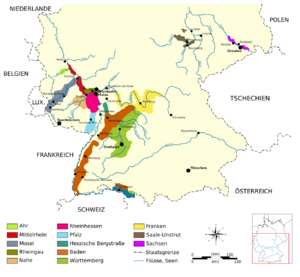List of German wine regions facts for kids
Germany is famous for many things, and one of them is its delicious wine! But did you know that not all German wines are the same? They are sorted into different groups based on where they come from and how good they are. This helps people know what kind of wine they are buying.
German wine regions are organized by the quality of the wine they produce. There are different levels, from everyday table wine to very special wines.
Contents
Germany's Wine Regions: A Kid-Friendly Guide
Think of it like different levels of quality for wine:
- Tafelwein is like everyday table wine, simple and easy to drink.
- Landwein is a step up, often from a specific countryside area.
- Qualitätswein bestimmter Anbaugebiete (QbA) means "quality wine from specific growing regions." These wines have to meet certain rules.
- Prädikatswein is the highest quality level, with very strict rules about how the grapes are grown and harvested.
Germany also has special rules about where wine grapes can be grown to make these quality wines. These areas are divided into four sizes, from very large to very small:
- Anbaugebiet is a major wine region, like a big state.
- Bereich is a district within that region, like a county.
- Großlage is a collection of vineyards within a district, like a group of neighborhoods.
- Einzellage is a single vineyard, like one specific farm.
Almost all single vineyards belong to a larger group, but a few special ones are "großlagenfrei," meaning they don't belong to a Großlage. However, they all belong to a Bereich and an Anbaugebiet.
Major Wine Regions (Anbaugebiete)
Germany has 13 main wine regions, called Anbaugebiete. Most of them are in the western part of the country. As of 2010, there were 41 districts (Bereiche), 160 groups of vineyards (Großlagen), and 2,632 single vineyards (Einzellagen).
Here are the 13 major wine regions:
- Ahr
- Baden
- Franconia (also known as Franken)
- Hessische Bergstraße
- Mittelrhein
- Mosel
- Nahe
- Palatinate (also known as Pfalz)
- Rheingau
- Rheinhessen
- Saale-Unstrut
- Saxony (also known as Sachsen)
- Württemberg
Let's look at some of these regions and their smaller parts.
Ahr
The Ahr region has 1 main district (Bereich) called Walporzheim/Ahrtal. Within that, there is 1 group of vineyards (Großlage) called Klosterberg.
Baden
The Baden region is quite large, with 9 districts (Bereiche) and 16 groups of vineyards (Großlagen). Some of its districts include Badische Bergstraße, Bodensee, and Kaiserstuhl.
Franconia (Franken)
In Franconia, there are 3 districts (Bereiche) and 22 groups of vineyards (Großlagen). Two single vineyards here are special because they don't belong to a Großlage. Some districts are Maindreieck and Steigerwald.
Hessische Bergstraße
This region has 2 districts (Bereiche) and 3 groups of vineyards (Großlagen). The districts are Starkenburg and Umstadt.
Mittelrhein
The Mittelrhein region has 2 districts (Bereiche) and 12 groups of vineyards (Großlagen). These include Loreley and Siebengebirge.
Mosel
The Mosel region is well-known and has 6 districts (Bereiche) and 19 groups of vineyards (Großlagen). Some of its districts are Bernkastel, Burg Cochem, and Saar.
Nahe
The Nahe region has 1 district (Bereich) called Nahetal, which contains 7 groups of vineyards (Großlagen).
Palatinate (Pfalz)
The Palatinate is a large region with 2 districts (Bereiche) and 25 groups of vineyards (Großlagen). Its districts are Mittelhaardt-Deutsche Weinstraße and Südliche Weinstraße.
Rheingau
The Rheingau region has 1 district (Bereich) called Johannisberg, which includes 10 groups of vineyards (Großlagen).
Rheinhessen
Rheinhessen is another large region with 3 districts (Bereiche) and 24 groups of vineyards (Großlagen). Its districts are Bingen, Nierstein, and Wonnegau.
Saale-Unstrut
This region has 2 districts (Bereiche) and 5 groups of vineyards (Großlagen). The districts are Schlossneuenburg and Thüringen.
Saxony (Sachsen)
Saxony has 3 districts (Bereiche) and 4 groups of vineyards (Großlagen). These include Dresden, Elstertal, and Meissen.
Württemberg
Württemberg has 6 districts (Bereiche) and 17 groups of vineyards (Großlagen). Some of its districts are Bayerischer Bodensee, Kocher-Jagst-Tauber, and Remstal-Stuttgart.
Other Wine Regions
Tafelwein Regions
There are 4 main regions that produce German Tafelwein, which is a simpler, everyday wine. These also have 8 smaller sub-regions. Some examples include Rhein and Mosel sub-regions.
Landwein Regions
There are 20 wine regions that produce German Landwein, which is a step up from Tafelwein. These wines often come from specific countryside areas. Examples include Ahrtaler (from the Ahr region) and Pfälzer (from the Palatinate region).


